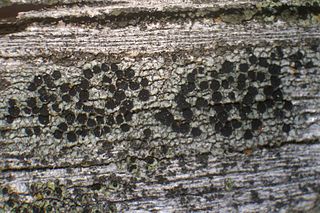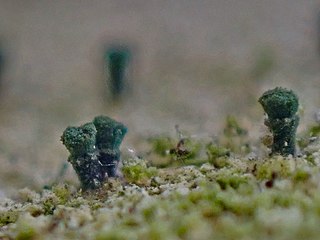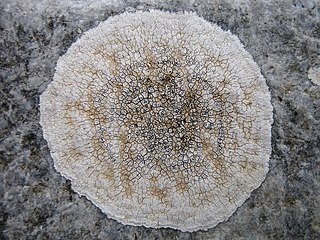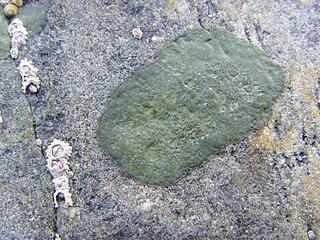
Chaenotheca is a genus of lichenized fungi within the family Coniocybaceae. The sexual reproduction structures are a mass of loose ascospores that are enclosed by a cup shaped exciple sitting on top of a tiny stalk, having the appearance of a dressmaker's pin, hence the common name pin lichen. Genus members are also commonly called needle lichens.

Aspicilia is a genus of mostly crustose areolate lichens that grow on rock. Most members have black apothecia discs that are slightly immersed in the areolas, hence the common name"Given the same reason, the naming of Aspicilia is derived from the Greek word for "shield concave".

Calicium is a genus of leprose lichens. It is in the family Caliciaceae.

Tetramelas is a genus of lichenized fungi in the family Caliciaceae.
Clavascidium is a genus of lichens in the family Verrucariaceae. The genus was circumscribed in 1996 by Austrian lichenologist Othmar Breuss. Because the type species of the genus, Clavascidium umbrinum, has been shown using molecular phylogenetics to belong to genus Placidium, Cécile Gueidan and colleagues proposed to unite Clavascidium with Placidium in a 2009 publication. Despite this, the genus has been retained in recent publications of fungal classification.
Polyblastia is a genus of lichenized fungi in the family Verrucariaceae. As of 2020, it consists of about 40 species combined with about 50 orphaned species. The main difference with the genus Verrucaria is related to spores, which are muriform in Polyblastia.

Microcalicium is a genus of lichen-forming fungi in the order Pertusariales. It is the only genus in the monotypic family Microcaliciaceae. These taxa were circumscribed by the Finnish lichenologist Edvard August Vainio in 1927, with Microcalicium disseminatum assigned as the type species.

Chaenothecopsis is a genus of about 40 species of pin lichens in the family Mycocaliciaceae. Many of the species are resinicolous, meaning they grow on conifer resin or other plant exudates. Most common host plants are trees in the genera Abies, Picea, and Tsuga.
Stenocybe is a genus of fungi in the family Mycocaliciaceae. It has 14 species.

Thamnolia is a genus of lichens in the family Icmadophilaceae. Members of the genus are commonly called whiteworm lichens.

Circinaria is a genus of crustose lichens in the family Megasporaceae. It was circumscribed by Johann Heinrich Friedrich Link in 1809.

Lobothallia is a genus of lichens in the family Megasporaceae. Species in the genus have foliose thalli that become crustose areolate in the center with age, and grow on calcareous to siliceous rocks. The crustose part of the body may keep its lower cortex, though not always. Dark brown to black apothecia may be sunken into the surface of the thallus, as indicated in the common name puffed sunken disk lichen. Members grow to 3–5 cm (1.2–2.0 in) or more radiating lobes (placodioid). The photobiont is green alga from the genus Trebouxia. The genus is represented in Eurasia, Asia, North Africa, Central America, western North America, and Australia.
Sclerophora is a genus of lichen-forming fungi in the family Coniocybaceae. Largely restricted to temperate latitudes, three of its species have been reported in North America.
Leif Tibell is a Swedish lichenologist and Emeritus Professor at the University of Uppsala. He is known for his expertise on calicioid lichens. He was awarded the Acharius Medal in 2012 for lifetime achievements in lichenology.

Chaenotheca brachypoda is a species of lichen in the family Coniocybaceae. It was first described in 1816 by Erik Acharius as Coniocybe brachypoda. Leif Tibell transferred it to the genus Chaenotheca in 1987.

Circinaria caesiocinerea is a species of crustose lichen belonging to the family Megasporaceae. It was first described as Lecanora caesiocinerea in 1869 by William Nylander, but was transferred to the genus Circinaria in 2010 by Anders Nordin, Sanja Savić, and Leif Tibell.

Circinaria calcarea is a species of crustose lichen in the family Megasporaceae. It was first described as a new species by Carl Linnaeus in his 1753 work Species Plantarum. Linnaeus named it Lichen calcareus, as he classified all lichens in the eponymously named genus. The species has had an extensive taxonomic history, resulting in dozens of synonyms. In 2010, it was placed in its current genus, Circinaria, following molecular phylogenetic analysis of the Megasporaceae.
Atla is a genus of crustose lichens in the family Verrucariaceae. It has nine species that grow on rocks or on soil.

Wahlenbergiella is a genus of saxicolous (rock-dwelling), crustose lichens in the family Verrucariaceae. It has three species, all of which live in marine intertidal zones where they get periodically immersed in seawater. Wahlenbergiella closely resembles another lichen genus that includes marine species, Hydropunctaria. Wahlenbergiella was circumscribed in 2009 by Cécile Gueidan and Holger Thüs. They initially included two species: W. striatula, and the type,W. mucosa. The generic name honours Swedish naturalist Göran Wahlenberg, who originally described both of these species.
Tetramelas pulverulentus is a species of lichenicolous (lichen-dwelling) fungus in the family Caliciaceae. It was originally described as a new species by Martino Anzi in 1860. The type specimen was collected in Italy. Swedish lichenologists Anders Nordin and Leif Tibell transferred it to the genus Tetramelas in 2005 based on molecular phylogenetic analysis. It is closely related to Tetramelas phaeophysciae but differs from that species in its ascospores, which have three septa.












